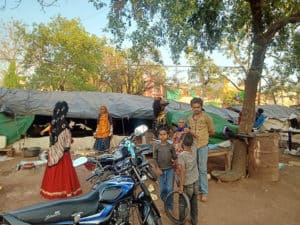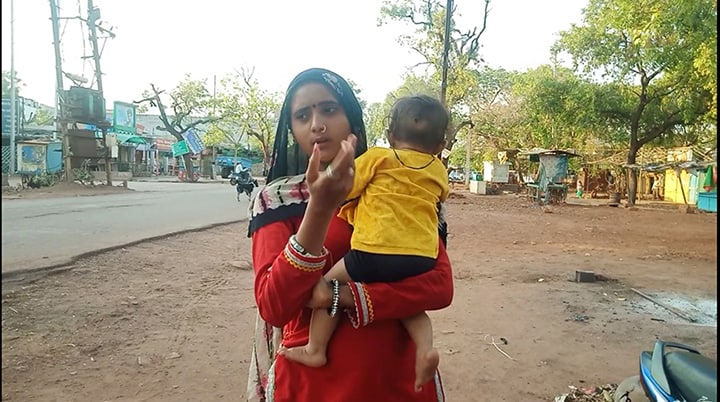The culturally rich Gadia Lohar Community has been historically marginalised and the lockdown due to the Coronavirus is increasing their suffering
Mamta, 25, holds her one-year-old daughter close to her chest as the police van passes by.
From within the van, a policeman can be heard announcing that nobody should venture out of their homes unless for essentials as shops are open till 5 pm.
Mamta’s husband left her four months ago, leaving her dependent on her father. She is spending her days trapped in a makeshift mudhouse. “My husband is gone, I don’t have his support, we hardly earn Rs 200-300 a day, now with Corona, we aren’t going anywhere. What should we do? Should we poison our kids?” she says with tears in her eyes.
Mamta belongs to the Gadia Lohar community, living in Shivpuri district of Madhya Pradesh. A community which is categorised as a ‘nomadic tribe’ that depends primarily on making and selling kitchen utensils and instruments in different cities. According to the Renke Commission report, 57% of such families live in tents/temporary structures and a majority of them lack access to essential services and basic amenities, such as water, sanitation, electricity, and most importantly, access to and benefits of government schemes.
Since the lockdown was announced, this already marginalised community has been facing a host of problems including finding the next meal. “We travel to sell the utensils and things we make from iron. We go to Delhi, Morena, Gwalior, for this purpose but since this lockdown has been announced, we are sitting idle waiting for help and have nothing much to eat” says 67-year old Chaturbhuj.
He has a family of 12 and the ration he gets through the BPL ration card is not enough. “We only get rice, for how many days will we eat rice? As my family is big, the food grains we get are not enough,” he adds.
The government provides 4 kg wheat and 1 kg rice per person on a ration card per month. And on March 26, Modi government announced that it would send double the quota of food grains. States can now distribute 10 kg of foodgrains by Public distribution system. The centre government also said that it would send 1kg pulse. But many from the Gadia Lohar community complain that they are only getting rice, not wheat, which is their staple diet. Pulses are not being distributed in MP.

The settlements in Shivpuri the Patriot visited had no access to toilets or sanitation. People here purchase drinking water which costs them Rs 20 every day and for bathing and other necessities they collect water from the nearby tubewells. The houses they live in are temporary structures made of clay. “I don’t know much about cleanliness, we live on footpaths, and when it rains our roofs start leaking. This is how we live,” says Malti.
During our visits, we found that no one here had a face mask and was not observing norms of social distancing. And though they know that they should maintain distance from strangers, the way the community lives makes distancing very difficult. Most of the day, women and men sit in groups either cooking or just talking. “Our daughters used to go for work, we make items like clay pots and lamps but since the lockdown, we all are sitting here doing nothing. If someone falls sick, what will we do? Where will we go with no money in our pocket?” asks Malti.
In 2019, a non-profit organisation Housing and Land Rights Network surveyed 58 settlements of the community in Delhi, with an estimated population of at least 25,000 and published a report. The report “Mapping the Marginalized: Delhi’s Gadia Lohar Community.” iT states that 64% of the surveyed Gadia Lohar settlements did not have access to toilets; 44% did not have access to schools, and 41.4% did not have access to clean drinking water. Their shelters do not even qualify as ‘jhuggis’. In every city, they face eviction, as they live on roadsides and are not eligible for government schemes that affect their health and livelihood opportunities.
The HLRN report also says that the Union government once made an effort to provide housing for them in Delhi but the effort failed. This was part under the Gadia Lohar Rehabilitation Scheme. The Delhi Development Authority constructed 34 shops-cum-homes for them in Mangolpuri in 2003. But the houses and shops were never allotted to them.
When sanitation and cleanliness are at the core of the fight against Covid-19, the challenges these communities face is immense. Even in a pandemic, the primary problem they face comes not from the Coronavirus but from other diseases arising from the unhygienic conditions they live in.
The Gadia Lohars, as per the community’s legends, worked under the Maharana Pratap as blacksmiths in Rajasthan’s Chittorgarh area. They were skilled craftsmen making swords and shields. When the Mughals captured the Chittorgarh fort, they left the city and became nomads, moving their belongings from place to place in bullock carts. The bullock carts they used gave them the name ‘Gadiya Lohar’, ‘gadiya’ referring to bullock carts
Many in the community do not possess documents like ration cards, which makes their condition even worse. However, Gadia Lohar community members living in Shivpuri have Jan Dhan accounts. They say when they went to the bank, they had to wait in long lines for their money, “No one listens to the poor. When money came in our accounts, we waited outside the banks in long queues as we had nothing,” says Chaturbhuj.
In desperation, some young men from the community, he says, tried going to different localities to sell the items they make. In doing so, they broke the lockdown and were beaten up by the local police, making matters worse for them.
This is the plight of a nomadic tribe which was already facing heavy odds. The pandemic has driven them to the edge of despair.
(Cover: Mamta with her one-year-old daughter)





